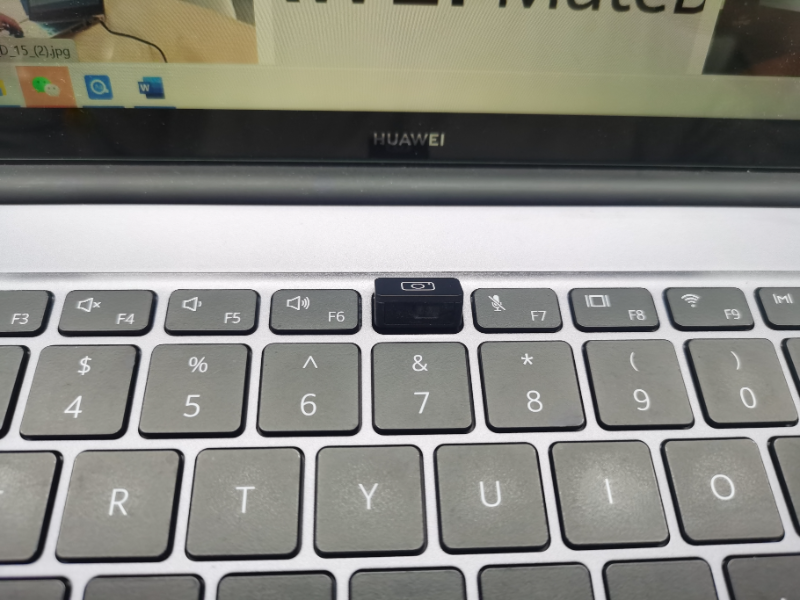- The webcam peers up at you from below, showing a good amount of chin and an upsetting amount of nostril.
- Comparatively, brands like Apple, ASUS, and Dell shine through their meticulous attention to detail and commitment to quality.
OUR TAKE
Huawei products have a massive following in China. The company initially focused on manufacturing smartphones but has since expanded to include a variety of electronic products such as tablets, smartwatches, and computers. Whenever a new product is launched, it’s practically a scene of frenzy, selling out faster than tickets during peak travel seasons. Four years ago, I decided to get a Huawei laptop, only to find there was just one model left to choose from. As a consumer eagerly anticipating a laptop from this beloved Chinese smartphone brand, I assumed it wouldn’t disappoint. However, when I personally experienced its webcam design, it left me speechless — in a bad way.
–Revel Cheng, BTW reporter
1. The webcam angle is outrageous
Huawei, in a stroke of design bravado, decided to relocate the webcam to an unexpected locale—nestled inconspicuously within the keyboard, hiding under a button adorned with the innocuous camera icon. At first glance, it appears ingenious: no more bulky add-on shutters or makeshift solutions with black tape to safeguard your privacy. With a simple press, the camera retreats into its covert sanctuary. It’s sleek, it’s modern, it’s Huawei.
But alas, the real-world unveiling of this innovation didn’t quite live up to the hype. What initially sparked admiration quickly turned to horror the moment users activated the camera. The quality itself? Acceptable. The angle? Dreadful. Whether users are seated at a tidy desk or lounging casually on the sofa, the webcam insists on capturing you from the least flattering perspective imaginable. It gazes up from below, generously highlighting chins and revealing nostrils in a way that would make even the most seasoned selfie-taker cringe. If there’s one lesson selfie culture has taught us, it’s the art of finding your best angle. And folks, let me assure you, this isn’t it. Not for anyone.

2. The battery life is not good enough
Firstly, let’s talk about battery life — a crucial aspect for any laptop user on the go. Despite Huawei’s reputation for efficient battery management in their smartphones, the same cannot be said for their laptops. The battery drains alarmingly fast, barely lasting 2 to 3 hours even with moderate usage. This shortfall is baffling, especially when considering the technological advancements and consumer expectations in today’s market. As someone who depends on a laptop for work and mobility, this limitation severely hampers productivity and necessitates constant access to power outlets.
3. A number of laptops had broken shafts
Durability concerns further compound my dissatisfaction. Reports of broken shafts in numerous Huawei laptops have surfaced, indicating a potential flaw in build quality or structural integrity. This issue not only raises reliability questions but also undermines the trust consumers place in Huawei’s hardware craftsmanship. A laptop should withstand everyday use without such fundamental structural failures, yet these incidents highlight a significant oversight in quality control.
4. It is easy to get hot
Heat management is another Achilles’ heel for Huawei laptops. During extended use, the device tends to overheat, causing discomfort and potentially affecting performance. There have even been cases where both the motherboard and the CPU have been burned. This overheating issue not only impacts user comfort but also raises concerns about long-term reliability and potential hardware damage. In a competitive market where thermal efficiency is a key differentiator, Huawei’s struggle in this area is a significant disadvantage.
5. Lag for no apparent reason
Moreover, the sporadic lag in performance adds another layer of frustration. Despite seemingly capable hardware specifications, Huawei laptops often experience inexplicable slowdowns that disrupt workflow and user experience. This lag persists even under normal operating conditions, indicating possible optimisation issues or software conflicts that detract from the overall performance promise.
Also read: Huawei hosts cloud database summit in Thailand
Also read: Nokia set to win 5G contract with portugal’s MEO, replacing Huawei
The larger the radius, the more unclear it is, and the more unclear it will be in the next 10-20 years, so everyone will have more doubts, but doubts do not mean how big a problem there is. Also, questioning is valuable, scientists are inherently skeptical, otherwise how would they discover something new? He doesn’t believe that new discoveries will be made, so questioning itself is an inevitable by-product of the process of moving forward.
Ren Zhengfei, founder of Huawei

Behind Huawei’s webcam debacle: When innovation faces an uphill angle
So why did Huawei opt for such an unconventional design? Picture this: a boardroom filled with eager designers and engineers brainstorming over the next revolutionary laptop design. Amidst the sea of ideas—floating screens, holographic keyboards, you name it—someone boldly suggests, “Let’s hide the webcam in the keyboard!”
Perhaps it was a quest for minimalist perfection, where every component serves a dual purpose or vanishes into sleek obscurity. Imagine the thrill of maximising precious screen real estate while avoiding the unsightly bulge of traditional webcams. No more awkward protrusions ruining the laptop’s sleek lines or the hassle of fumbling with clunky webcam covers.

But here’s the catch: in the pursuit of this minimalist utopia, Huawei inadvertently unleashed a new breed of photographic challenges. Users now face the unenviable task of mastering the art of avoiding unflattering chin angles and nostril close-ups. It’s the kind of design decision that prompts even the most patient user to question whether innovation sometimes comes at too high a cost.
While Huawei’s boldness in redefining laptop aesthetics is commendable, the practical realities of using their webcam may elicit more groans than cheers. It’s a reminder that in the world of tech design, every leap forward may involve a stumble or two. Here’s hoping their next innovation strikes the perfect balance between form and function—preferably without turning users into unwitting stars of their own unflattering webcam saga.
My experience with Huawei laptops underscores the paradox of innovation: pushing boundaries can yield groundbreaking results, but at times, it risks compromising practicality and user experience. Huawei’s journey in laptop design exemplifies this delicate balance between innovation and usability—a reminder that technological advancement should always prioritise seamless functionality over flashy novelties.
In conclusion, while Huawei excels in pushing design boundaries, the practical realities of their laptops—be it the unconventional webcam placement, battery life woes, durability concerns, heat management issues, or performance hiccups—leave much to be desired. As consumers, we cherish innovation that enhances our daily lives, not one that introduces new complexities or frustrations. Here’s hoping Huawei’s future innovations strike a better balance between bold creativity and user-centric functionality, delivering products that truly resonate with their loyal fanbase and beyond.
I have never supported the term “independent innovation”, I believe that science and technology are the common wealth of mankind, and we must step on the shoulders of our predecessors to move forward, so as to shorten the process of our entry into the world’s leading position.
Ren Zhengfei, founder of Huawei
Pop quize
Which one below is the best high-end gaming laptop?
A: MacBook Pro 15-inch Laptop
B: Dell XPS 13 Laptop
C: Asus ROG Zephyrus G14
D: HP Spectre x360 Laptop
The correct answer is at the bottom of the article.
The 3 best laptop brands for 2024
Comparatively, brands like Apple, ASUS, and Dell shine through their meticulous attention to detail and commitment to quality. Here are 3 best laptop brands for reference:
1. Apple: MacBook Air M3, MacBook Pro M3
Apple is one of the most recognisable electronics companies in the world. Apple products have become synonymous with exceptional build quality, and the company is well-known for its amazing customer support. Since 2020, Apple has been producing its own ARM-based M-series processors for their MacBooks instead of relying on Intel chips. This change has made MacBooks among the most powerful and power-efficient laptops on the market. Another advantage of MacBooks is their integration with other products in Apple’s ecosystem, supporting features like Continuity Camera, Airdrop, Handoff, etc.
2. ASUS: ROG Zephyrus G14, Zenbook 14 OLED
Founded in 1989 by four members who had worked at Acer, ASUS, also known as ASUSTek, is one of the largest laptop manufacturers in the world. It’s also one of the best gaming laptop brands and often sponsors Esports events and players. ASUS makes a wide range of laptops, including ultraportables, mobile workstations, gaming laptops, and Chromebooks. ASUS often experiments with new form factors and features, like dual-screen laptops, touchpads with an integrated numpad, a customisable dial (like the ASUS ProArt Studiobook Pro 16 OLED (2021), and 2-in-1 gaming tablets like the ASUS ROG Flow Z13.
3. Dell: XPS 13
Dell is an American company founded in 1984 by Michael Dell. The company makes desktops, laptops, workstations, monitors, and a wide range of computer peripherals. It’s one of the largest laptop manufacturers, with well-known brands like XPS, Precision, Latitude, and Inspiron. In 2006, Dell acquired Alienware, which is now considered one of the best gaming laptop brands on the market. High-end Dell laptops like the XPS, Precision, and Alienware models often have unique designs that stand out among the crowd and generally provide a great user experience.
The correct answer is C.

